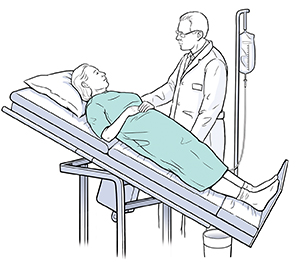Having a (Video) Urodynamic Study
A urodynamic study is a group of tests that look at the bladder, sphincters, and urethra and their ability to store and release urine. These tests may be done in your doctor’s office, a clinic, or a hospital. The study may take up to an hour or longer. This depends on which tests you have. The tests are generally painless. A small tube (catheter) will be placed into your bladder and in your rectum. You won’t need sedating medicine.
Your doctor may recommend this study to help find the cause of certain problems. These include:
-
Urine leakage.
-
Frequent urination.
-
Painful urination.
-
Sudden, strong urges to urinate.
-
Problems starting a urine stream.
-
Problems emptying the bladder completely.
-
Recurrent urinary tract infections.
 |
| The equipment used for the study varies depending upon the facility and what tests are done. |
How to prepare for a urodynamic study
You might be asked to stop certain medicines and change your fluid intake. You may also be asked to arrive to the study with a full bladder. You may need to keep a "bladder diary" for a few days. If so, you will write down what fluids you drink and when you make trips to the bathroom.
Tests that may be done
-
Uroflowmetry. This test measures the amount and speed of urine you void from your bladder. You urinate into a funnel. It’s attached to a computer that records your urine flow over time. The amount of urine left in your bladder after you urinate may also be measured right after this test. The results of this test can show if your bladder muscles are weak or if your urine flow is blocked.
-
Postvoid residual measurement. This test measures how much urine is left in your bladder after you urinate. It can be done with an ultrasound. Or it can be done by putting a catheter into your bladder to drain and measure the urine that remains.
-
Cystometry. This test finds out how much your bladder can hold. It also measures how strong your bladder muscle is. And it checks to see how well the signals work that tell you when your bladder is full. Your doctor will fill your bladder with sterile water or saline solution through a catheter. Your doctor will ask you to report any sensations you feel. You'll be asked if they are similar to symptoms you have felt at home. Your doctor may ask you to cough, stand and walk, or bear down during this test.
-
Electromyogram. This test helps evaluate the muscle contractions that control urination, such as sphincter muscle contractions. Your doctor may put electrode patches or wires near your rectum or urethra to make the recording. They may ask you to try to tighten or relax your sphincter muscles during this test.
-
Pressure flow study. This test measures your detrusor, urethral, and abdominal pressures. Detrusor is the muscle around the bladder walls. It relaxes to let your bladder fill. And it contracts to squeeze out urine. A pressure flow study is often done after cystometry. You’re asked to urinate while a probe in your urethra measures pressures.
-
Video cystourethrography. This test takes video pictures of urine flow through your urinary tract. It can help find blockages or other problems. The bladder is filled with an X-ray contrast fluid. Then X-ray video pictures are taken as the fluid is urinated out. Ultrasound imaging may also be used.
-
Ambulatory urodynamics. This test can be used to evaluate you while you're doing normal activities.
After a urodynamic study
You might experience slight pain for a few hours when you urinate. To help with the pain, try taking a warm bath. Holding a warm or cool, damp washcloth over the opening of your urethra may also help.
Urinary tract infections are not common after this study. But contact your doctor if you have pain while you urinate, have blood in your urine, or have any new urgency or frequency to urinate.
Getting your results
After the study, you’ll get dressed and return to the consultation room. Test results may be ready soon after the study is finished. Or you may go back to your doctor’s office in a few days for your results. You can talk with your doctor about the study report and your treatment choices.
Online Medical Reviewer:
Lalitha Kadali
Online Medical Reviewer:
Melinda Murray Ratini DO
Online Medical Reviewer:
Raymond Kent Turley BSN MSN RN
Date Last Reviewed:
4/1/2025
© 2000-2025 The StayWell Company, LLC. All rights reserved. This information is not intended as a substitute for professional medical care. Always follow your healthcare professional's instructions.